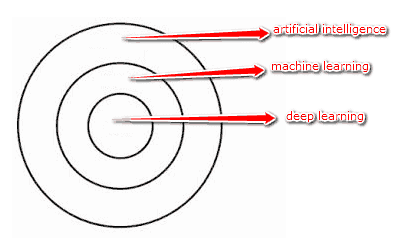Almost everyone would agree that the time has come to properly differentiate between Artificial Intelligence (AI), Machine Learning (ML), and Deep Learning (DL).
This is owing to the fact that a lot of people do not know the difference between these terms.
Are you also caught up in the confusion?
An artificial intelligence survey conducted by a business finance and accounting company known as Sage revealed that 43% of participants in the US and 47% of participants in the UK disclosed that they did not know what Artificial Intelligence was all about.
As a result, leaders in the tech industry have realized the pressing need for them to put AI and its subcategories (machine learning, deep learning) into proper business vocabulary that they would be easily understood by everyone.
Fortunately, in this post, we will be looking to differentiate between AI, ML and Deep Learning. These three terms are often used interchangeably; however, they mean different things.
Let’s go deeper into the nitty-gritty of these terms.
What Is Artificial Intelligence?
Just as the name implies, artificial intelligence relates to the process of integrating the intelligence of human beings into machines.
To get a better understanding, let us look at the words “Artificial” and “Intelligence” separately.
The word artificial means something that is not natural or something produced by human beings. While the word intelligence, on the other hand, means the ability to apply knowledge, skill or understand something.
Thus, AI relates to a process of empowering machines with a set of algorithms so that they can perform tasks that were originally carried out by human beings.
Machines powered by AI are categorized into three fundamental levels; general, narrow, and active.
The general AI machines are machines that can move from one place to another, they can manipulate objects, and they are good problem solvers.
The narrow AI machines, on the other hand, are developed to perform certain specific tasks in a way that could be compared to humans or even better. One example of narrow AI is the technology used to categorize or arrange pictures on Pinterest.
Active AI machines are machines that have the capacity to out-perform humans in a lot of tasks.
Examples of artificial intelligence systems are seen in image recognition systems, speech recognition systems, and other computer programs.
What Is Machine Learning?
Machine learning relates to a process where computers are being equipped with the capacity to learn something.
The concept of machine learning is to provide a platform where machines can learn certain things by themselves based on a set of given data, and then these machines are able to make decisions based on this data.
Machine learning is essentially a sub-category under Artificial intelligence; it deals with certain techniques that empower computers to know certain things based on a set of data.
In machine learning, machines are fed with algorithms until they get to a point where they begin to make decisions on their own. When faced with a translation need, localization and translation services offered by The Word Point and other brands can come in handy.
If you want to learn more about machine learning, this free resource on demystifying machine learning would be of great help.
What Is Deep Learning?
Deep learning is basically a sub-category of machine learning. In fact, deep learning is the process of actualizing machine learning.
In deep learning, machines are trained to process information, just like human beings.
As humans, we use our brains to identify, process, and classify different types of information; this is also the focus of deep learning. The algorithms of deep learning seek to accomplish the same task as the human brain.
Artificial Neural Networks (ANNs) are a type of algorithm that is used to mimic the human brain or the way humans make decisions.
The automatic learning technology in deep learning is based on deep neural networks. Deep learning makes use of neurons and layers that are interconnected.
Putting It All Together
From the above-stated, we can deduce that Artificial Intelligence, Machine Learning, and Deep learning are all interrelated, yet, they represent different things at the same time.

Thanks to deep learning, so many aspects of the field of artificial intelligence are beginning to come to light. Have you heard about driverless cars or self-driving cars? They are made possible with the help of deep learning.
Artificial intelligence machines are pre-programmed to undertake certain tasks. This means that you need to program some set of activities in them to enable them to function properly.
Machine learning and deep learning machines, on the other hand, learn by themselves without the help of human instructional codes.
In machine learning, the machines are exposed to a large amount of data from which they learn by themselves, implement tasks by themselves, apply their knowledge without human help, and learn from their mistakes.
Machine learning means that robots or machines have to use their own imagination. An example of a machine learning system that uses its own imagination is Google AlphaGo. This machine-learning system defeated Lee Sedol (world champion) at the game of Go.
Ultimately, AI and its sub-categories (Machine learning and Deep learning) can have immense benefits for organizations. Organizations can now tap into the potentials of artificial intelligence in making strategic plans geared towards a more effective marketing campaign, cost-effectiveness and achieving a high return on investment (ROI). Also, localization services from The Word Point can have immense benefits for organizations.
Final Thoughts
To sum up, now you understand the difference between artificial intelligence, machine learning, and deep learning. Let us go over the basic points again.
Artificial intelligence is all about impacting intelligence, cognitive ability, and human wisdom to machines.
Machine learning focuses on the need for machines to learn and complete tasks without human intervention. The machine is only provided with data, and on their own, they learn and apply the knowledge in completing tasks, if they make mistakes, they are able to learn from their mistakes without human help. Deep learning is a major advancement in artificial intelligence. It is described as the future of artificial intelligence. When provided with enough data, the results from deep learning can be impressive.
Author Bio

Frank Hamilton has been working as a translator at translation service. Frank Hamilton is a blogger and translator from Manchester. He is a professional writing expert in such topics as blogging, digital marketing and self-education. He also loves travelling and speaks Spanish, French, German and English.





